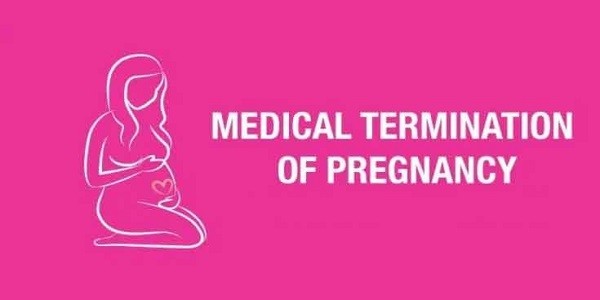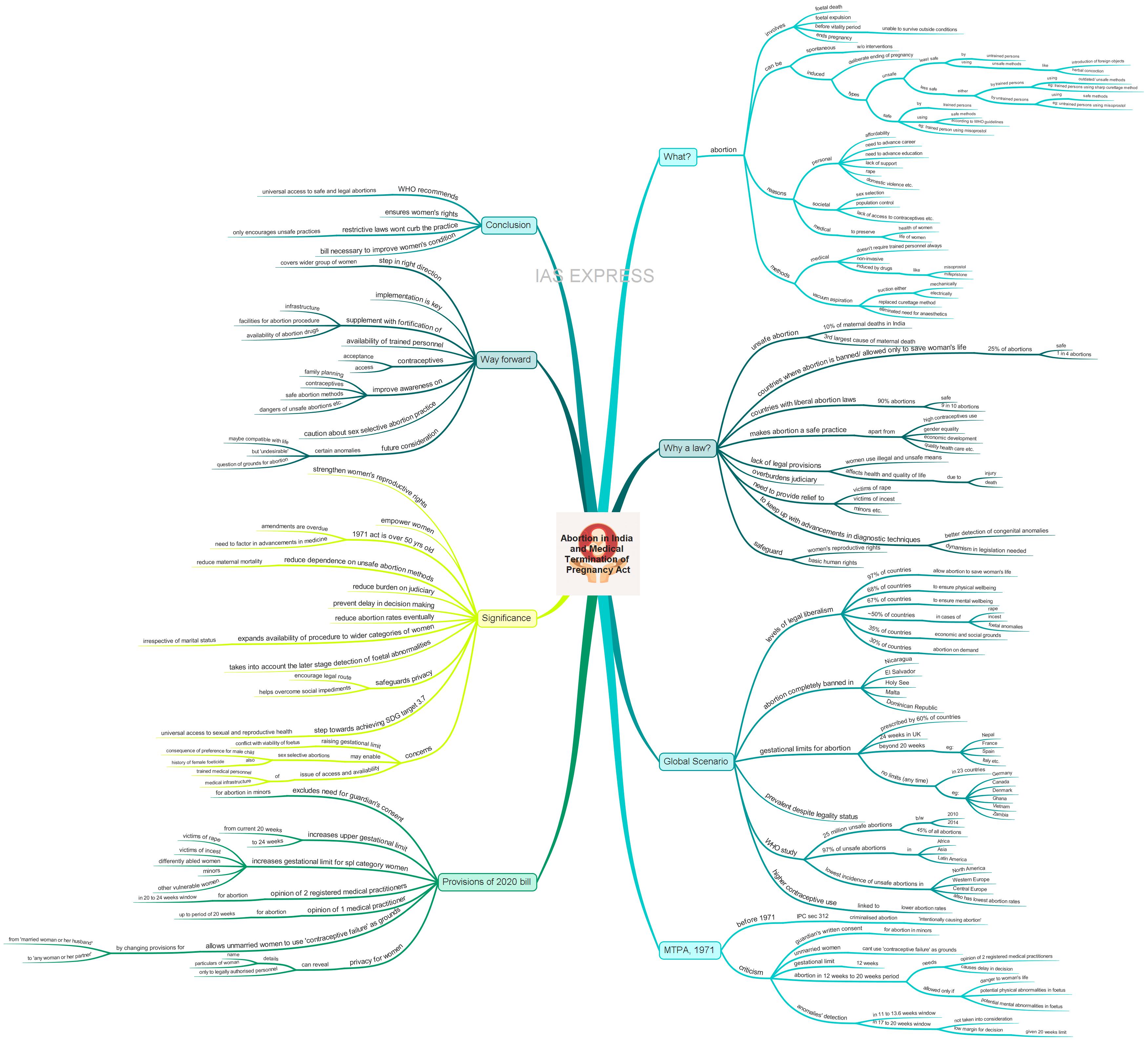Abortion in India & Medical Termination of Pregnancy (Amendment) Bill, 2020

From Current Affairs Notes for UPSC » Editorials & In-depths » This topic
IAS EXPRESS Vs UPSC Prelims 2024: 85+ questions reflected
The union cabinet recently approved the Medical Termination of Pregnancy (Amendment) Bill, 2020. The move is expected to liberalise the practice of abortion and is long overdue. The move has been called for by many women’s rights groups and even the Supreme Court. The move is also significant as liberal abortion laws have been linked with a decline in unsafe abortions and abortion rates in general.
What is abortion?
- Abortion is the process by which a foetus is expelled from the uterus before it can survive outside conditions, thus ending the pregnancy and resulting in foetal death.
- It can be either spontaneous (occurring without intervention) or induced (deliberate ending of pregnancy).
- It is done for a variety of reasons such as:
- Personal reasons– affordability, need to advance a career, education, lack of support, domestic violence, rape, etc.
- Societal reasons– preference for children of a certain sex, population control measures, lack of access to contraceptives, etc.
- Medical reasons– abortions may be done to preserve the health or life of the mother.
- Induced abortion is classified as follows:
- Unsafe abortions:
- Least safe abortion: performed by an untrained person using dangerous methods like herbal concoctions and the introduction of foreign objects.
- Less safe abortions: abortions performed either by a trained person using outdated/ unsafe methods or by an untrained person using a safe method. Eg: a trained person using the ‘sharp curettage’ method, an untrained person using the misoprostol drug, etc.
- Safe abortions: performed by trained healthcare workers using recommended methods according to WHO guidelines. Eg: a trained person using misoprostol drug regime.
- Methods used in India for abortion:
- Medical methods: Abortion is induced by drugs. This is non-invasive and can be used in case of unavailability of trained healthcare workers. Misoprostol and mifepristone are the drugs used for the purpose.
- Vacuum Aspiration: Performed in hospitals either using the manual or electric version. The method reduced the need for anaesthetics and replaced the outdated curettage method.
Why is an abortion law needed?
- Unsafe abortion accounts for 10% of maternal deaths in India- the 3rd leading cause of maternal deaths in the country.
- A Lancet study noted that in countries where abortion is banned or allowed only to save the woman’s life, only 1 in 4 abortions are safe i.e. only 25% of the abortions are safe.
- In countries where the practice is legal to a larger extent, about 9 in 10 abortions are safe. This is 90% of abortions.
- The study reported that apart from high levels of contraceptive use, gender equality, economic development, and quality health care, permissive laws on abortion contribute to making abortion a safer practice.
- Lack of legal provisions makes women resort to illegal and unsafe abortions thus compromising health and quality of life due to the risk of injury and death.
- Lack of legal provisions for abortion beyond the current gestation limit of 20 weeks has led to applications seeking permission for the same in the courts. This has increased the burden on the overloaded judiciary.
- The necessity of comprehensive abortion law to provide relief to victims of incest, rape, etc. and also to minors.
- Given the advancements in diagnostic techniques, the detection of congenital abnormalities is becoming easier. An abortion law that takes such dynamism into account is needed to terminate anomalous pregnancies which are incompatible with life.
- Well-Functioning abortion law is required to safeguard the reproductive rights and also the basic human rights of women.
What is the global scenario with respect to abortion laws?
- Most of the countries allow abortions to save the woman’s life (97%) while fewer countries allow the same for saving the physical (68%) and mental (65%) wellbeing of the woman.
- Nearly half of the countries in the countries in the world allow it in cases of rape, incest and foetal abnormality.
- Economic and social reasons are grounds for abortion in 35% of the countries while on-demand abortion is allowed in 30% of the countries.
- Abortion is completely banned in certain countries- Nicaragua, El Salvador, Dominican Republic, Malta and Holy See.
- Over half of the countries (60%) have gestational limits for legal abortion- e.g: up to 24 weeks in the UK and beyond 20 weeks period is allowed in countries like France, Italy, Spain and even Nepal in case foetal abnormalities are detected.
- 23 countries allow termination of pregnancy at any time at the woman’s request. Eg: Germany, Denmark, Canada, Ghana, Vietnam and Zambia.
- Irrespective of the legal status of the practice, abortion continues to prevail in countries across the world.
- According to a WHO study, 25 million abortions between 2010 and 2014 were performed by unsafe methods. This accounts for 45% of all abortions in that period.
- 97% of unsafe abortions occur in Africa, Asia and Latin America.
- Countries in North America and the western and northern parts of Europe mostly resort to safe abortions. They also have the lowest abortion rates.
- Improved access to contraception has been strongly linked to a reduction in the use of abortions.
What are the provisions of the Medical Termination of Pregnancy Act?
- Before the 1971 act came into being, abortion was considered criminal according to IPC section 312. Is was considered as ‘intentionally causing miscarriage’.
- The Medical Termination of Pregnancy (Amendment) Bill, 2020 seeks to amend the provisions of the 1971 act.
- The 1971 legislation had been criticised over some of its provisions:
- Need for guardian’s written consent when the abortion is to be performed on a minor.
- Unmarried women cannot use the failure of contraceptives as grounds for seeking an abortion.
- Pregnancy can be terminated legally only within the 12 weeks
- Delay in the decision-making process brought on by the need for the opinion of not less than 2 registered medical practitioners in case of abortion of pregnancies beyond the 12 weeks period but within the 20 weeks, The abortion is allowed in this period only if the medical practitioners are of the opinion that the pregnancy would cause risk to the woman’s life or cause the child to develop physical or mental abnormalities if continued.
- It doesn’t consider the fact that congenital abnormalities may be detected at a later stage of pregnancy i.e. 17 to 20 weeks period. This gives a low margin for deciding on abortion within its current legal limit of 20 weeks. It only considers the abnormalities detected in 11 to 13.6 weeks
- The 2020 amendment bill seeks to make the following changes:
- The bill has excluded the need for a guardian’s consent for abortion in minors.
- It increases the upper limit of the gestation period from 20 weeks to 24 weeks for abortion among special categories of women: victims of rape, incest, vulnerable women including differently-abled women and minors.
- It increases the upper gestational limit for abortion from the current 20 weeks to 24 weeks.
- It introduces the requirement of opinion from 2 registered medical practitioners for terminating pregnancies in the 20 weeks to 24 weeks window.
- However, it has proposed that the opinion of just one registered medical practitioner as sufficient for abortion in the gestational period of up to 20 weeks.
- It has allowed unmarried women to seek abortions on the ground of contraceptive failure- i.e. from provisions for ‘married woman or her husband’ to ‘any woman or her partner’.
- It calls for maintaining the privacy of women undergoing abortions. The particulars of the women cannot be revealed to anybody except a legally authorised person.
What is the significance of the proposed amendments?
- The move is expected to strengthen the reproductive rights of women in India and also empower them.
- The 1971 act is over 50 years old and doesn’t factor in the advancements in the medical diagnostic field.
- It is a move towards reducing dependence on unsafe abortions by untrained personnel and consequently reduce maternal mortality in India.
- It will reduce the burden on the judiciary.
- It will also prevent time delays in decision-making processes and eventually lead to a drop in abortion rates as seen in the countries in North America and Western Europe.
- It will provide much-needed relief to women who were victims of rape, incest, etc. and special categories of women.
- It expands the availability of the procedure to women irrespective of marital status thus ensuring the health of a wider group of women.
- It takes into account the later stage detection of foetal abnormalities and the possibilities of a wanted pregnancy changing into an unwanted one as a consequence.
- It safeguards the privacy of women seeking abortions thus encouraging them to opt for the legal and medically recommended route. This is a step to overcoming the social reasons for unsafe abortions.
- It is a move towards achieving the SDG target 3.7– universal access to sexual and reproductive health.
- However, there are reasons for concerns too. Extending the upper gestational limit for abortions raises concerns about the viability of the foetus.
- Liberalising the abortion laws in a country noted for its preference of male child and history of female foeticide raises concerns.
- While liberal laws will improve the practice’s legal standing, there is still the issue of accessibility and availability of trained personnel and medical infrastructure.
What is the way forward?
- The amendment is a step in the right direction. Its provisions are needed to ensure the availability of the facility to a wider category of women.
- Like with all legislations, implementation is the key to it actually serving the purpose.
- The new norms must be supplemented with the adequate fortification of medical infrastructure and the availability of abortion procedures and drugs.
- The availability of trained personnel must also be ensured.
- Improving contraceptives’ access and acceptance is key to reducing abortion rates.
- There is a need to improve awareness about family planning, contraceptives, safe methods of abortions and the dangers of unsafe abortions.
- Need to be cautious about the liberalisation of the procedure being misused for sex-selective abortions– the main reason for India’s skewed sex ratio.
- It is possible that the perception, of what anomalies constitute a fit enough ground for abortion, changes. This anomaly could be compatible with life and yet be considered undesirable. This may prove to be a cause of concern in the future. Hence, there is a need for legislation to keep up with the changes in the medical field.
Conclusion
The WHO recommends universal access to safe and legal abortions as a key component of ensuring the rights of women- as restricting the same hasn’t stopped but only encouraged the increase in unsafe abortions. The 2020 amendment bill is a necessity for improving the conditions of Indian women.
Test Yourself
Critically analyse the need for liberal abortion law in India with reference to the 2020 Medical Termination of Pregnancy (Amendment) Bill. (250 words)
If you like this post, please share your feedback in the comments section below so that we will upload more posts like this.


